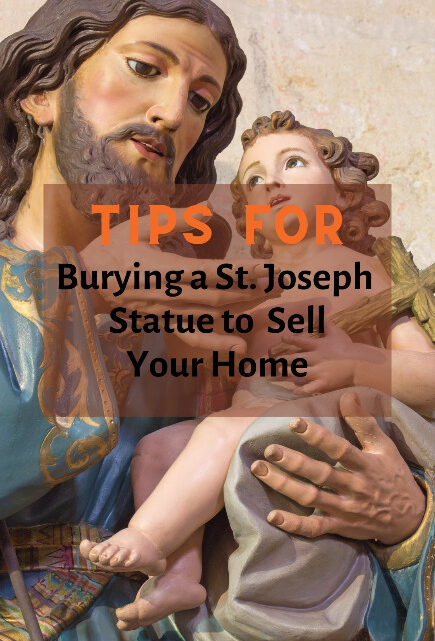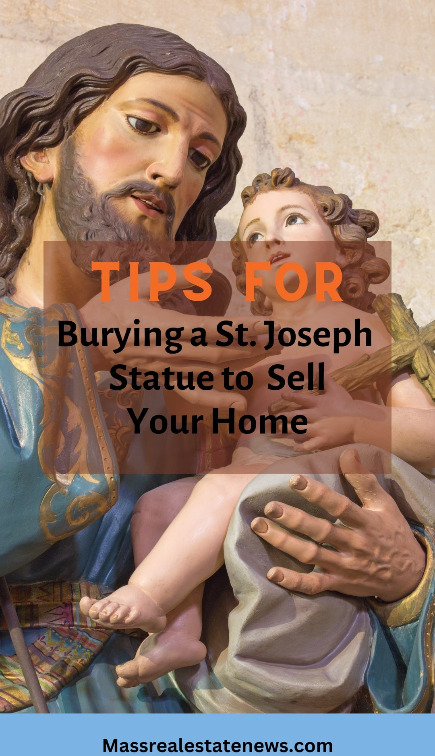Have you heard about using St. Joseph for house sales?
If you’re struggling to sell your Massachusetts home, it might be time to tap into a centuries-old tradition that many swear by. The St. Joseph Statue Home Selling Kit.
This method combines deep faith with a sound real estate marketing plan in an intriguing way that has won the hearts of thousands worldwide.
Prepare to embark on a journey packed with faith, ritual, and tradition. We will examine the complete guide to using a St. Joseph statue to sell your home faster in Massachusetts.
Expect an array of fascinating stories, expert tips, and practical advice. The tips will all aim to unlock the spiritual potential of this cherished Catholic tradition!
Using a St. Joseph statue is a tradition believed to help sell a house by invoking the intercession of St. Joseph, the patron saint of home sellers.
To utilize this practice, you can purchase a small statue, bury it in your yard, or display it near the front door or a window overlooking the for sale sign.
Daily prayers or recitations to St. Joseph are often done until the house sells. While there are mixed sentiments about its effectiveness, many sellers have reported positive outcomes.
From years of experience as a Massachusetts Realtor, I know many who have buried St. Joseph to increase their chances of a timely sale.
There are just as many who consider it one of several real estate myths.
Luckily for me I have never needed to use this home sales tactic. Even in buyer’s markets I’ve been fortunate enough to use sound marketing methods that have provided my clients success.
Does this mean that it isn’t worth a shot? Not necessarily. No harm, no foul. It may be worth trying, especially when selling a stigmatized property.
Keep reading to learn everything you need to know about this tradition.
What Are St. Joseph Statues?
Regarded as a saint by various Christian traditions, St. Joseph is a biblical figure often depicted as a silent guardian in Christmas nativity scenes, watching over his wife, Mary, and the newborn baby in the manger.
With his association as the patron saint of carpenters, house builders, families, and working people, St. Joseph has also been revered as the patron saint of home sellers.
It is common for religious individuals to have statues of varying sizes to pay homage to the saint. Sometimes, these statues are buried as part of a tradition believed to be beneficial when selling a house.
As the story explains, this is likely attributed to Joseph’s experiences of uprooting his family multiple times and establishing a home in unfamiliar lands.
Understanding the St. Joseph Statue Tradition
Many homeowners find home selling exhausting and nerve-racking. The prospect of having a property stay on the market for months can create a sense of frustration and anxiety.
It’s understandable why people might resort to unique and sometimes unconventional methods to expedite the process.
One such approach that has gained popularity, particularly among Catholics, is using the St. Joseph statue tradition to sell their homes.
Imagine a family putting their house up for sale but to no avail. They pray daily for a quick sale, yet nothing seems to work.
At this point, someone – likely a real estate agent or someone who has done it before – suggests burying a statue of St. Joseph in their front yard. Since it’s believed to increase the chances of a successful sale, they decide to give it a chance.
Origin and Belief System
The St. Joseph statue tradition has existed since the 1500s when St. Teresa of Avila buried a medal of Saint Joseph while building convents with her fellow nuns.
However, its application as a home-selling method only gained mainstream traction in the 1990s. Today, it remains popular among homeowners looking to sell properties quickly.
The burying statuettes related to specific religions or beliefs aren’t necessarily new. Different cultures have long utilized objects believed to attract good energy or ward off evil spirits in their endeavors.
Believers suggest seeking the intercession of St. Joseph by burying his statue in hopes that he helps find suitable buyers for one’s home quickly.
The instructions are precise. First, purchase a small statue and wrap it in towels or plastic bags to protect it from moisture or other outdoor elements. Then, bury it in your yard. Many will also use a St. Joseph prayer.
Now that we understand this tradition and how it started, let’s explore practical steps for using the statue to sell your house.
How to Use a St. Joseph Statue for Home Selling in Massachusetts
Selling a home can be stressful, especially if the process takes longer than you want it to. That’s why some homeowners use alternative methods to speed up the sale process.
This statue, believed to bring good luck and speed up the sale process, has gained popularity among home sellers. Let’s walk you through everything you need about using a St. Joseph statue to sell your Massachusetts property.
Finding and Preparing Your Statue
The first step in using a St. Joseph statue to sell your home is finding one that meets your needs. Many options are available online, at Catholic stores, or on Amazon. Once you have acquired one, ensure it is clean and free of damage before proceeding.
Next, it’s time to prepare your statue for burial or display. Some homeowners wrap their statues in cloth or plastic bags to protect them from environmental elements during burial. Others choose to cleanse their statues with holy water or have them blessed by a priest before burying them.
Some people who intend to bury the statue would select an ideal spot near a “For Sale” sign as part of the preparation. Others face it from the house where they want the statue to bring blessings.
Homeowners must decide whether they wish to bury or display their statues instead. Both are said to bring about positive results during real estate transactions effectively.
For homeowners who choose not to bury their statues, displaying them in prominent places, such as near doors or windows overlooking the “for sale” sign, may also be effective.
Once your St.Joseph statue is adequately prepared, it’s time for placement and prayer.
- In a study published in 2020, 32% of sellers who buried a St. Joseph statue reported that their property sold more quickly than the market average.
- According to a report by an online marketplace specializing in religious articles, demand for St. Joseph home-selling kits increased by nearly 20% in 2019.
Choosing the Burying Spot
Selecting the spot is the first step in burying a St. Joseph statue to sell your home. Most homeowners choose the front yard, near the “for sale” sign, or facing away from the house.
Some may also bury the statue in a flower bed or near a tree. Selecting an area with easy access is crucial. Remember that placing it near the “for sale” sign could be prone to theft or damage.
For instance, one homeowner buried their St. Joseph statue in their front yard beside a small bush near their mailbox. They opted for this location because it was quickly accessible and wouldn’t raise eyebrows amongst neighbors.
There are, however, several options available for burying St. Joseph as follows:
There Are Various Options For Burial
- Put him by the roadside with the statue positioned to face outward from the residence, symbolizing departure.
- Some believe in burying him upside down, indicating an attempt to free oneself from the house by selling it.
- Place him upright, with the back on the ground, and their face or body directed towards the house.
- Select a location three feet from the back of the house or close to a flower bed.
- If you want to sell a condo, one option is to bury the statue in a flower pot.
Praying Practice During the Sale Period
Now that you have found a suitable spot for burying your St. Joseph statue, what’s next? Once you’ve buried the statue, you must begin praying or following specific prayer practices.
While different sellers observe varying practices based on their belief systems, most follow nine days of prayer before excavating St. Joseph and placing him in his new home upon closing the sale.
Some sellers may use pre-written prayers, while others may opt for personalized prayer routines each day. Regardless of how one chooses to pray, intentionality and consistency are crucial elements during this period.
Think of it as watering plants regularly; if you’re inconsistent and don’t provide enough water daily, they won’t thrive.
During this time, homeowners may consider displaying the statute near windows overlooking the property’s “for sale” sign or at their thresholds.
Daily prayers can accompany this with family members or friends who similarly wish for the quick sale of your property.
After Sale Statue Treatment
Once your home is sold and ready to hand over the keys to the new owners, you must retrieve your St. Joseph statue from the yard. This act serves two purposes. You must respect St. Joseph, who was called upon to intercede in the selling process. It is also a preventative measure against any potential superstitions from arising.
Some sellers worry that leaving the statue behind could bring bad luck to their subsequent real estate transactions or homeownership. Even though these notions are not based on facts or logic, some people might take them seriously.
You may keep the statue with you after digging it up or donate it to someone who might find value in invoking St. Joseph’s assistance for their selling process.
Whatever path you pick, ensure that the statue is never left behind for anyone else. Any attempt to sell a house with an already buried statue would seem tacky and disrespectful. It will also be ineffective if a new one doesn’t replace it.
Ultimately, burying a St. Joseph statue when selling your home may seem superstitious on the surface. However, it has become a widespread cultural practice among home sellers worldwide.
However, it’s vital to remember that this option must be seen as another potential tool rather than an ultimate solution.
Committed owners should follow general home-selling advice. Once you’re under contract, follow a sound closing checklist. It will keep you on track and prevent mistakes.
Best of luck with your sale!










No Comment